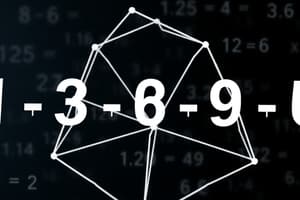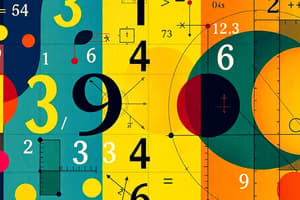Podcast
Questions and Answers
What are the basic arithmetic operations?
What are the basic arithmetic operations?
- Addition, subtraction, multiplication, division (correct)
- Addition, subtraction, order of operations, multiplication
- Addition, division, substitution, multiplication
- Exponentiation, multiplication, division, subtraction
Which of the following number systems includes all rational numbers?
Which of the following number systems includes all rational numbers?
- Real numbers (correct)
- Natural numbers
- Irrational numbers
- Integers
What is the primary purpose of set theory in mathematics?
What is the primary purpose of set theory in mathematics?
- To analyze geometric figures
- To solve linear equations
- To calculate probabilities
- To classify and describe relationships between mathematical objects (correct)
Which geometric property is used to analyze the relationship between angles and lines?
Which geometric property is used to analyze the relationship between angles and lines?
What is the main focus of algebra?
What is the main focus of algebra?
What type of function relates a variable to its squared value?
What type of function relates a variable to its squared value?
Which of the following numbers is prime?
Which of the following numbers is prime?
What does modular arithmetic focus on when dividing integers?
What does modular arithmetic focus on when dividing integers?
What do congruences represent in modular arithmetic?
What do congruences represent in modular arithmetic?
What is the primary function of limits in calculus?
What is the primary function of limits in calculus?
What do derivatives measure?
What do derivatives measure?
In linear algebra, what are matrices primarily used for?
In linear algebra, what are matrices primarily used for?
Which concept in probability describes the likelihood of events?
Which concept in probability describes the likelihood of events?
What is the purpose of descriptive statistics?
What is the purpose of descriptive statistics?
What are the components of graph theory?
What are the components of graph theory?
What do counting techniques in discrete mathematics help determine?
What do counting techniques in discrete mathematics help determine?
What are geometric transformations like translations and rotations used for?
What are geometric transformations like translations and rotations used for?
How are integrals applied in calculus?
How are integrals applied in calculus?
Flashcards
Addition
Addition
The process of adding two or more numbers together.
Subtraction
Subtraction
The process of finding the difference between two numbers.
Multiplication
Multiplication
The process of repeatedly adding a number to itself.
Division
Division
Signup and view all the flashcards
Integers
Integers
Signup and view all the flashcards
Rational numbers
Rational numbers
Signup and view all the flashcards
Irrational numbers
Irrational numbers
Signup and view all the flashcards
Number theory
Number theory
Signup and view all the flashcards
What are congruences?
What are congruences?
Signup and view all the flashcards
What are limits?
What are limits?
Signup and view all the flashcards
What are derivatives?
What are derivatives?
Signup and view all the flashcards
What are integrals?
What are integrals?
Signup and view all the flashcards
What are vectors?
What are vectors?
Signup and view all the flashcards
What are matrices?
What are matrices?
Signup and view all the flashcards
What is probability?
What is probability?
Signup and view all the flashcards
What is statistics?
What is statistics?
Signup and view all the flashcards
What is descriptive statistics?
What is descriptive statistics?
Signup and view all the flashcards
What is inferential statistics?
What is inferential statistics?
Signup and view all the flashcards
Study Notes
Basic Mathematical Concepts
- Arithmetic operations: Addition, subtraction, multiplication, and division are fundamental to many mathematical applications. These operations are used to solve basic problems and are the building blocks for more advanced concepts.
- Number systems: Understanding different number systems like natural numbers, integers, rational numbers, irrational numbers, and real numbers is crucial for various mathematical disciplines. Each set has specific properties relevant to complex calculations.
- Sets and logic: Sets are collections of objects, and understanding set theory helps in classifying and describing mathematical objects and their relationships. Logical operations, like conjunction, disjunction, and implication, are used in proofs and to establish connections between mathematical statements.
- Geometry: Geometry deals with shapes, sizes, and spatial relationships. Basic principles like angles, lines, and triangles are essential to spatial reasoning and problem-solving. Different geometric figures have specific formulaic representations of properties like area or volume.
- Algebra: Algebra deals with symbols and variables to represent numbers and relationships. Solving equations and inequalities is a primary application of algebra. Properties of operations, such as the commutative and associative properties, help in achieving simplified expressions.
- Functions: Functions relate inputs to outputs. Understanding different types of functions like linear, quadratic, exponential, and logarithmic is fundamental for various mathematical models and applications.
Number Theory
- Prime numbers: Prime numbers are natural numbers greater than 1 that are only divisible by 1 and themselves. They underpin various mathematical constructions, including cryptography.
- Divisibility rules: Rules for determining if one number is divisible by another are valuable for simplifying calculations or identifying relationships.
- Factorization: Breaking down a number into its prime factors provides insight into its properties and helps in solving problems related to divisibility and other number-theoretic concepts.
- Modular arithmetic: This is a system of arithmetic that deals with remainders when integers are divided by a fixed number. The system has important applications in computer science, especially in cryptography.
- Congruences: Congruences are equivalences related to remainders in modular arithmetic; they are used to solve problems involving number patterns and properties.
Calculus
- Limits: Limits are fundamental to calculus as they describe the behavior of a function as its input approaches a particular value. They form the basis for derivatives and integrals.
- Derivatives: Derivatives represent the instantaneous rate of change of a function and are used to find slopes of curves, maximum and minimum values, and other important properties.
- Integrals: Integrals represent the accumulation of a function and are used to find areas under curves, volumes of solids, and other important quantities. Integration and differentiation are inverse operations.
- Applications: Derivatives and integrals have various applications in physics, engineering, economics, and other fields. They are crucial for modeling and solving problems that involve change over time or accumulation over time.
Linear Algebra
- Vectors and matrices: Vectors represent quantities with both magnitude and direction, facilitating the study of geometric and physical phenomena. Matrices are rectangular arrays of numbers used to represent linear transformations and operations.
- Systems of linear equations: Linear equations with several unknowns can be represented using matrices, and solving these systems is a fundamental application in linear algebra.
- Determinants and eigenvalues: Determinants and eigenvalues are important concepts in linear algebra that provide information about transformations represented by matrices and how these systems behave in linear spaces.
Probability and Statistics
- Probability: Probability deals with the likelihood of events occurring. Calculating different kinds of probabilities has applications in numerous areas, such as risk assessment and prediction.
- Statistics: Statistics utilizes numerical data to understand patterns and draw conclusions. Statistics uses methods to analyze data sets and draw inferences about the population from samples.
- Descriptive statistics: Descriptive statistics summarizes data using measures of central tendency (mean, median, mode) and measures of dispersion (variance, standard deviation). These measures are useful for interpreting collected data.
- Inferential statistics: Inferential statistics uses sample data to make inferences about a population. It encompasses methods like hypothesis testing and confidence intervals.
Discrete Mathematics
- Logic: In discrete mathematics, formal logic plays a pivotal role in analyzing and proving arguments. Definitions using quantifiers and implications are common.
- Graph theory: Graph theory deals with representation of relationships among objects using graphs, comprised of vertices and edges.
- Counting techniques: Techniques to systematically count possible outcomes of events in finite cases include permutations and combinations. These methods are essential for understanding probabilities and problem-solving.
- Recurrence relations: These formulas describe how a sequence is related to previous terms. They are crucial for determining values or behaviors based on initial conditions or rules.
Geometric Transformations
- Translations, rotations, reflections, and dilations are geometric transformations that alter shapes. These transformations form the bedrock of geometric manipulations and proofs. Understanding these transformations is key to solving problems in various geometric settings.
- Vectors and transformations: Vectors can describe points as displacements from coordinate origins. These movements and transformations are foundational for representing planar and higher-dimensional shapes.
Studying That Suits You
Use AI to generate personalized quizzes and flashcards to suit your learning preferences.




